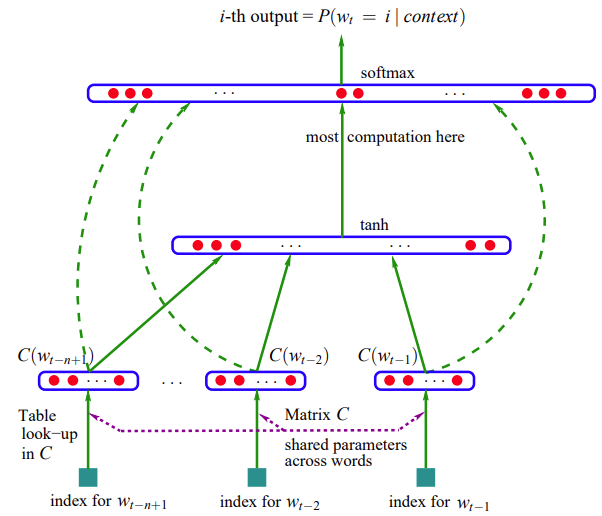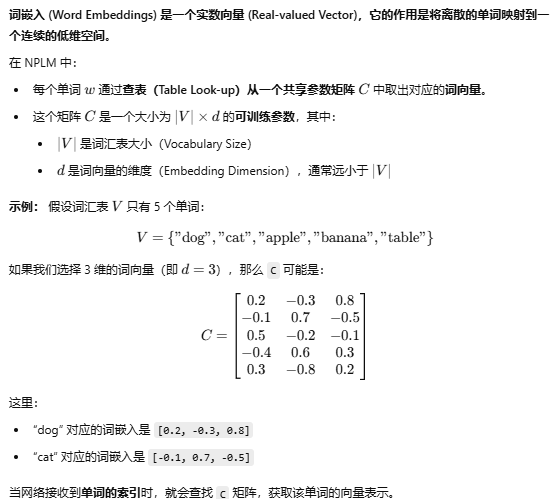Optimize Bigram based on Yoshua et.'s paper
Optimize Bigram based on Yoshua et.'s paper
Link
Brief Description
Introducing embedding word to solve the problem of matrix being too sparse
- Tranditional NLP: using
one_hotdog -> [1, 0, 0, 0, 0] - Embedding word: Take the
corresponding word vectorfrom a shared parametermatrix C- dog - > [1.324, 2.23, 4.234]
- PS: In this section, same logic in bigrams mapping
Note
- Overview
- The model is designed for predicting the probability of a word sequence.
- Uses one-hot encoding for input word representation.
- Applies a hidden layer with activation (e.g., tanh).
- Uses softmax to normalize output probabilities (ensuring they sum to 1).
- Encoding and Table Mapping C Table: A lookup table that maps input sequences to specific values. -
CX→C[X]is used to convert a 2D table (C) into 3D representations.- Example:
C[X][1][2]maps to a stored value.C[X][1][2]=C[1], meaning indexing refers to specific stored values.
- Example:
- Overfitting or Underfitting
- If training accuracy is high but validation accuracy is low, overfitting might be happening
- Parameter Tuning
- Optimize learning rate (draw the pic)
- Adjust batch size(big size for stabilize training, small size for improve generalization)
- Tune hidden layer sizes to balance model complexity and performance.
- Torch
- cross_entropy same as the last one
1 2 3 4
# cross_entropy equals probs = counts / counts.sum(1, keepdim=True) loss = -probs[torch.arange(len(xs)), ys].log().mean() + 0.01*(W**2).mean() loss
Scalar: only numberTensor: n-dim array- When to use scalars and when to use tensors?
- Scalars:
loss,autograd,mathematical operations - Tensors: Input to the neural network (
batch data) ormatrix operation
- Scalars:
- cross_entropy same as the last one
Code
Pre-setting
1
2
3
4
5
6
7
8
9
10
11
12
13
14
15
16
17
18
19
20
21
22
23
24
25
26
27
28
29
30
31
32
33
34
35
36
37
38
39
40
41
42
43
44
45
46
47
48
49
50
51
52
53
54
55
56
57
58
59
60
61
62
63
import random
words = open('names.txt', 'r').read().splitlines()
chars=sorted(list(set(''.join(words))))
stoi = {s:i+1 for i,s in enumerate(chars)}
stoi['.'] = 0
itos = {i:s for s,i in stoi.items()}
# context length: how many characters do we take to predict the next one?
# slide window
block_size = 3
# Calculate to make dataset respectively
def build_dataset(words):
X, Y = [], []
for w in words:
#print(w)
context = [0] * block_size
for ch in w + '.':
ix = stoi[ch]
X.append(context)
Y.append(ix)
context = context[1:] + [ix]
X = torch.tensor(X)
Y = torch.tensor(Y)
return X, Y
random.seed(1337)
random.shuffle(words)
n = len(words)
n1 = int(0.8 * n)
n2 = int(0.9 * n)
# Training data | validation data | test data
Xtr, Ytr = build_dataset(words[:n1])
Xdev, Ydev = build_dataset(words[n1:n2])
Xte, Yte = build_dataset(words[n2:])
g = torch.Generator().manual_seed(2147483647)
# Means each block has 10 dim -> [lens(X), 10]
C = torch.randn((27, 10), generator=g)
# Input layer to hidden layer(tanh)
W1 = torch.randn((30, 200), generator=g)
b1 = torch.randn(200, generator=g)
# Hidden layer to output layer
W2 = torch.randn((200, 27), generator=g)
b2 = torch.randn(27, generator=g)
parameters = [C, W1, b1, W2, b2]
# in this case: 30*200(W1) + 200(b1) + 200*27(W2) + 27(b2) + 27*10(C)
sum(p.nelement() for p in parameters)
for p in parameters:
p.requires_grad = True
# Help us the know the best learning rate
lre = torch.linspace(-3, 0, 1000)
lrs = 10**lre
lri = []
lossi = []
stepi = []
Training procedure
1
2
3
4
5
6
7
8
9
10
11
12
13
14
15
16
17
18
19
20
21
22
23
24
25
26
27
28
for i in range(200000):
# minibatch construct to reduce time
# returns a tensor of random indices of size 32
# for each indice, the range (0, Xtr.shape[0]) = (0, 1537)
ix = torch.randint(0, Xtr.shape[0], (32,))
# forward pass(training data only)
emb = C[Xtr[ix]] # (32, 3, 10)
h = torch.tanh(emb.view(-1, 30) @ W1 + b1) # (32, 200)
logits = h @ W2 + b2 # (32, 27)
loss = F.cross_entropy(logits, Ytr[ix])
#print(loss.item())
# backward pass
for p in parameters:
# avoid accumulating gradients
p.grad = None
loss.backward()
# update
lr = 0.1 if i < 100000 else 0.01
for p in parameters:
p.data += -lr * p.grad
# track stats
stepi.append(i)
lossi.append(loss.log10().item())
Samples
1
2
3
4
5
6
7
8
9
10
11
12
13
14
15
16
17
18
19
20
# sample from the model
g = torch.Generator().manual_seed(2147483647 + 10)
for _ in range(20):
out = []
context = [0] * block_size # initialize with all ...
while True:
emb = C[torch.tensor([context])] # (1,block_size,d)
h = torch.tanh(emb.view(1, -1) @ W1 + b1)
logits = h @ W2 + b2
probs = F.softmax(logits, dim=1)
ix = torch.multinomial(probs, num_samples=1, generator=g).item()
context = context[1:] + [ix]
out.append(ix)
if ix == 0:
break
print(''.join(itos[i] for i in out))
More details about word embedding
This post is licensed under CC BY 4.0 by the author.

